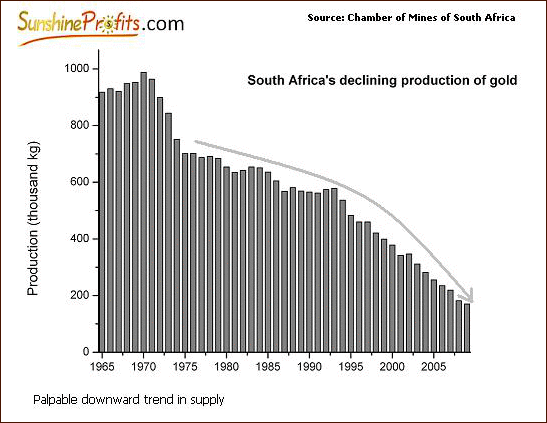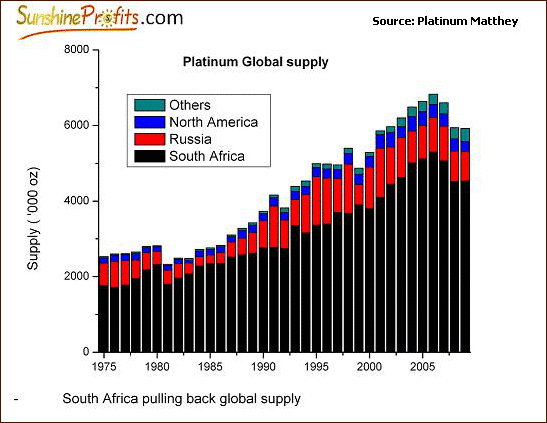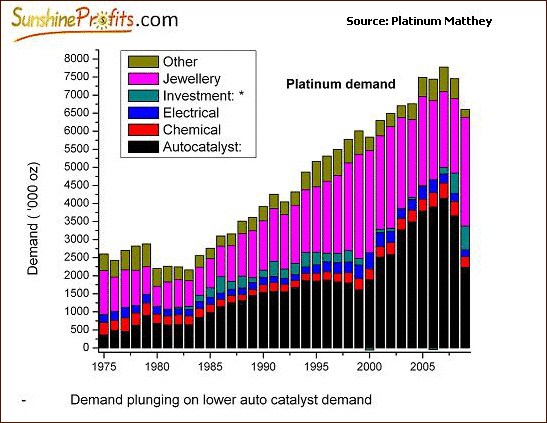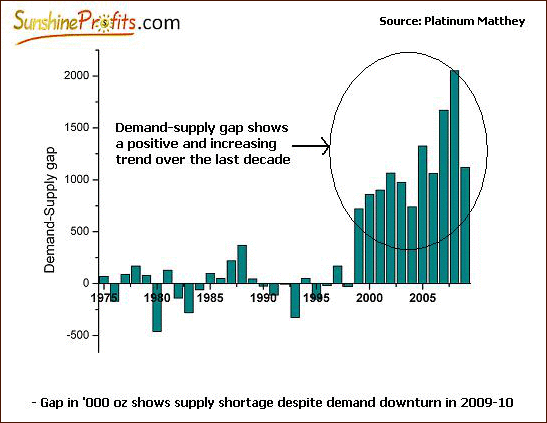Gold Tight Supply to Complement Robust Demand
Commodities / Gold and Silver 2010 Oct 27, 2010 - 10:14 AM GMTBy: Mike_Stall
 In an earlier article, we have established a robust outlook for precious metals’ demand in the long term. With the outlook on demand remaining upbeat, an analysis of the supply side will complete a fundamental study of the metals space. Generally, oversupply kills any optimism that strong demand creates. What is of more importance to investors is the demand supply gap rather than demand alone, as this is the prime determinant of long term prices.
In an earlier article, we have established a robust outlook for precious metals’ demand in the long term. With the outlook on demand remaining upbeat, an analysis of the supply side will complete a fundamental study of the metals space. Generally, oversupply kills any optimism that strong demand creates. What is of more importance to investors is the demand supply gap rather than demand alone, as this is the prime determinant of long term prices.
Supply is more influential in determining precious metals’ prices than any other commodity because of its scarcity. Simply put, gold is extremely rare to find and also whenever found, extraction and mining comes with significant costs. Global gold reserves (in the form of a natural resource) are constantly on the decline. The spike in mining activity over the past years has also led to the possibility of further supply deficit.
Interestingly, gold mined since 1900 accounts for over 80% of all-time gold production. Two-thirds of that volume of production has been in effect in the past 50 years alone. Demand for gold has been skyrocketing with the advent of newer investment instruments such as ETFs and derivatives. On the other hand, the supply side is starting to show signs of plateau-ing – a big boost for the long term prospects of gold as an investment avenue.
Our study of the supply side supports the bullish view of precious metals that is apparent from healthy demand. Current trends portend a flat supply for gold and silver compared to the past few years. Production of platinum and palladium will likely plummet further from current levels, creating a significant gap between demand and supply.
Palpable decline in gold production despite China’s highs
Declining mine production has been the primary concern for the precious metals market over the past few years and that is not likely to change. Some of the major producers including South Africa, the U.S., Australia, and Russia are falling short of their potential output, creating a global supply deficit. The depletion of reserves in the existing mines and the non-feasibility of new exploration are significant barriers to supply in the upcoming years.
Annual global gold production data shows that production has been declining over the past five years. Except China, disruption in output in the other nations has resulted in a global supply-demand mismatch. China has bucked this trend and is currently the largest producer of gold with production witnessing an upsurge in 2008 by approximately 33 MT, to 280.5 MT, accounting for 11% of global supply. In 2009, China's gold output grew 11.34% year-on-year to 313.98 tons. China's gold output for the first seven months of 2010 totaled 190.298 MT, 10.08% higher than the same period of 2009. China is gradually divesting dollar investments and consequently gold demand is on the upsurge. Production levels have been increased to meet this growing demand.
However, the production increment in China is offset by declining production in other regions. South Africa, once the largest producer of gold, is besieged by high production costs, declining ore quality, labor unrest, outdated mining technology and a severe power crisis. These challenges have impacted production capacities, further development and exploration.
In South Africa, the ratio of mining investments versus overall investments has declined during 2005-10.The South African mining industry is fraught with electricity shortages and increasing tariffs and production levels are expected to remain low in the upcoming years as well. Production from other countries in Africa such as Zimbabwe has declined by more than 50%, adding to the existing supply deficit. Higher cash costs and lower price realization have led to mine closures in Australia as well.

Supply deficit for platinum and palladium, silver less impacted
Worldwide, silver mine production is set to grow, albeit at a lower rate. After reaching a plateau in the recession, global mine production increased again in 2009, by approximately 4%, its seventh straight annual increase. Output in the upcoming years is likely to be driven higher by strong production increases in several South American countries and by higher output in Asia, principally in Turkey and China. China’s acceleration in silver production (approximately 280%) during the early half of the past decade is attributable to surging imports and that is expected to remain unchanged going forward.
On the supply downside for silver, some pullback is expected in Mexico following trends of labor unrest and poor weather in the past few years. On the whole though, we anticipate silver production from refining and smelting to remain flat to marginally upward in the next few years. Unlike other precious metals, a supply deficit is not likely to plague silver - if the economy gets stronger that is. Still, let's keep in mind that there is much less silver available in the aboveground supplies than it is the case with gold (in $ terms) and that it tends to outperform gold during final stages of a rally - just like it did at the end of the previous bull market at the beginning of the 80's. This, combined with the fact that silver demand is more closely tied with industrial activity, makes the case for investing in silver a good idea, especially with long-term approach and also for diversification purposes. Still, we could witness a short-term sharp correction in silver prices, before prices pick up again.
The supply situation could also become tighter in case of a continued economic depression, as silver is mostly mined as a by-product in industrial metals mines (such as copper).
For other precious metals (platinum and palladium), supply is expected to tighten further. The biggest signs of impending short supply are not only the lower production levels in existing mines in South Africa, but also the expected continuation of the downward trend in future exploratory and development activities.
Platinum fundamentals point to a continuing supply deficit that has emerged over the past decade or so. Even as demand plunged to abysmal lows during the recession, the platinum market was one of the few commodities that still managed to stay in a ‘demand outweighs supply’ scenario, emphasizing the robust fundamentals for the metal.



Like the platinum market, the palladium market is also slowly moving into a situation of supply shortfall. The oversupply in the palladium market before the recession was largely because of Russian exports; Russian stocks had not been sold since 2007 and stood at approximately 3 million oz by the end of 2008. However, ever since the economy has recovered, Russian stockpiles have almost entirely been offloaded. From being the third biggest contributor to the supply side, Russian stockpiles are no longer a prime factor in the supply equation for palladium.
The revival of production in Canada is expected to reduce the supply shortage. Exploration activities in Canada are alive and well. In mid 2009, a new PGM zone was discovered in Canada at the Las Dec Iles (LDI) mine during a prefeasibility study. Canada has also started to rollback a number of production cuts to meet increasing demand. However, the palladium market is still expected to be in overall deficit as Canada only constitutes close to a quarter of the global supply. The supply pullback in Russia and South Africa not only offsets the Canadian revival, but also places palladium as the most affected in terms of supply decline among the precious metals.
Overall, the supply side is most likely to contract for palladium and platinum, followed by gold. However, demand for gold overshadows its peers, resulting in the most significant demand supply gap favorable to prices. Demand for silver also ensures that despite a ‘not so contracted’ supply, the demand-supply gap remains favorable for higher prices.
Thank you for reading.
Mike Stall
Sunshine Profits Contributing Author
Sunshine Profits
Mike Stall is a writer on SunshineProfits.com. He is a commodity analyst in the precious and industrial metals space with a background in quantitative analysis of the financial markets. Mike Stall has been actively associated with studying gold, silver and base metal prices from both a quantitative as well as a fundamental standpoint. Mike Stall believes that commodities are superior investment instruments in comparison with most other asset classes as they tend to perform better in environments of inflation, fluctuating currencies and uncertain equity markets.According to him, the inherent and intrinsic value of a commodity often leads to safer and stronger returns that have been historically proven, fundamentally as well as quantitatively.
Interested in increasing your profits in the PM sector? Want to know which stocks to buy? Would you like to improve your risk/reward ratio?
Sunshine Profits provides professional support for precious metals Investors and Traders.
Apart from weekly Premium Updates and quick Market Alerts, members of the Sunshine Profits’ Premium Service gain access to Charts, Tools and Key Principles sections. Click the following link to find out how many benefits this means to you. Naturally, you may browse the sample version and easily sing-up for a free trial to see if the Premium Service meets your expectations.
All essays, research and information found above represent analyses and opinions of Mr. Radomski and Sunshine Profits' associates only. As such, it may prove wrong and be a subject to change without notice. Opinions and analyses were based on data available to authors of respective essays at the time of writing. Although the information provided above is based on careful research and sources that are believed to be accurate, Mr. Radomski and his associates do not guarantee the accuracy or thoroughness of the data or information reported. The opinions published above belong to Mr. Radomski or respective associates and are neither an offer nor a recommendation to purchase or sell securities. Mr. Radomski is not a Registered Securities Advisor. Mr. Radomski does not recommend services, products, business or investment in any company mentioned in any of his essays or reports. Materials published above have been prepared for your private use and their sole purpose is to educate readers about various investments.
By reading Mr. Radomski's essays or reports you fully agree that he will not be held responsible or liable for any decisions you make regarding any information provided in these essays or reports. Investing, trading and speculation in any financial markets may involve high risk of loss. We strongly advise that you consult a certified investment advisor and we encourage you to do your own research before making any investment decision. Mr. Radomski, Sunshine Profits' employees and affiliates as well as members of their families may have a short or long position in any securities, including those mentioned in any of the reports or essays, and may make additional purchases and/or sales of those securities without notice.
Przemyslaw Radomski Archive |
© 2005-2022 http://www.MarketOracle.co.uk - The Market Oracle is a FREE Daily Financial Markets Analysis & Forecasting online publication.



